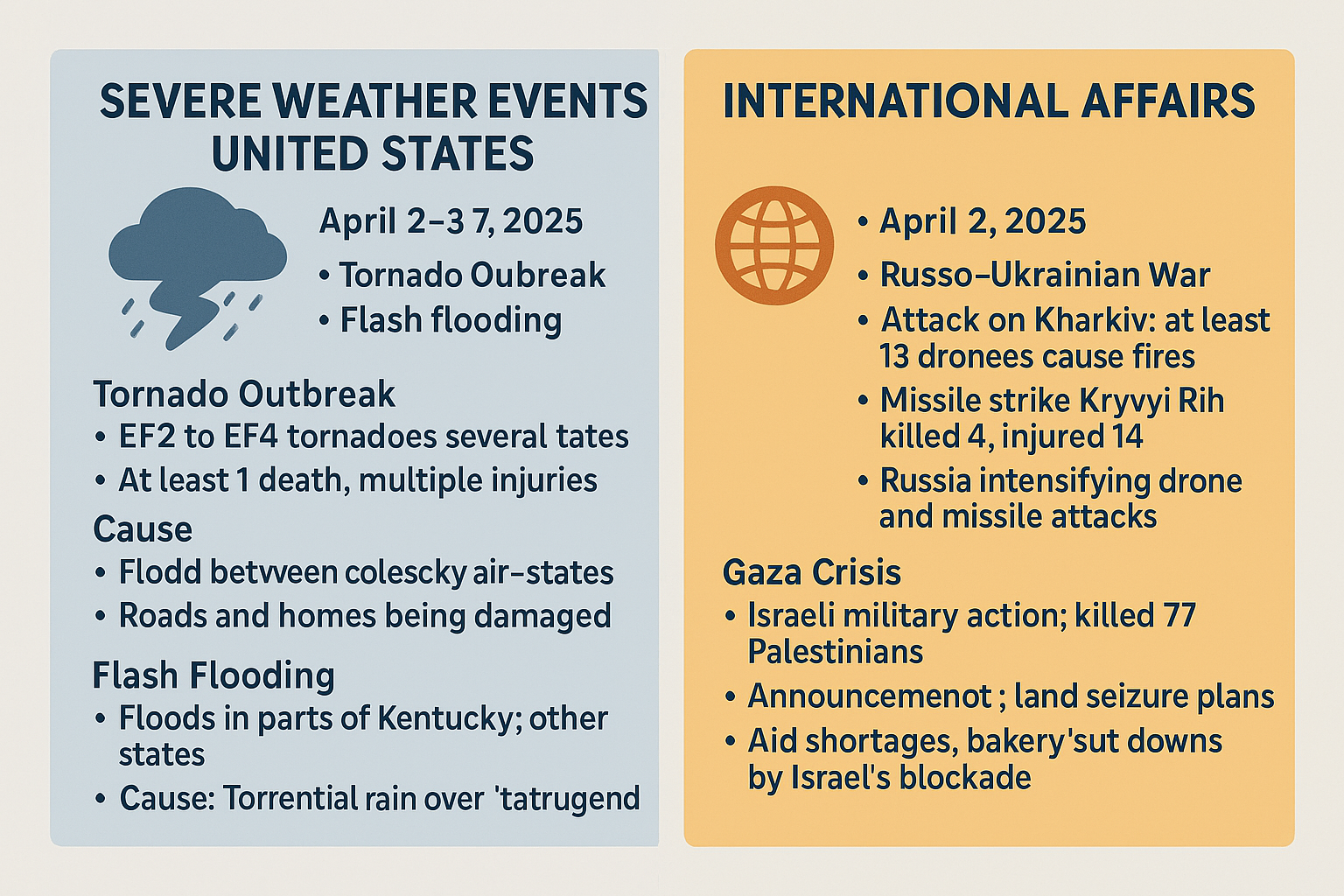Severe Weather Events — United States (April 2, 2025 and beyond)
From April 2 to April 7, the U.S. experienced a major multi-state weather crisis involving:
-
Tornado outbreaks
-
Flash flooding
-
Hailstorms and wind damage
This was one of the largest early-spring weather disasters in recent years. -
1. Tornado Outbreak
⚠️ Key Details:
-
EF2 to EF4 tornadoes ripped through states like:
-
Kentucky (declared a state of emergency)
-
Indiana, Tennessee, Mississippi, Illinois
-
-
Some tornadoes traveled long distances, destroying homes and uprooting entire neighborhoods.
-
Tornado sirens and alerts were widespread but warning lead times were short in many cases.
🧠 Why it happened:
-
A clash between cold, dry air from the northwest and warm, moist Gulf air created supercell thunderstorms.
-
These storms formed a “tornado alley-like” system — but shifted eastward due to changing climate patterns.
🧑🤝🧑 Human Impact:
-
At least 1 death confirmed (more injuries reported).
-
Hundreds of families displaced, homes lost.
-
Widespread power outages, especially in Kentucky and Tennessee.
-
Search & rescue operations continued for several days.
🌊 2. Flash Flooding
📍 Flood Zones:
-
Kentucky, West Virginia, Mississippi, Missouri, and parts of Alabama.
-
Several rivers overflowed, including the Ohio and Mississippi tributaries.
☔ Why?
-
Heavy rainfall (up to 5–7 inches in 24–48 hours) overwhelmed rivers and storm drains.
-
Prior rainfall in March had already saturated the ground.
🚨 Emergency Response:
-
Governors in multiple states activated National Guard units.
-
FEMA deployed early response teams.
-
Emergency shelters opened in churches, schools, and gymnasiums.
📉 Broader Implications:
-
The event sparked debate on climate change, urban planning, and lack of resilient infrastructure.
-
Insurers predicted hundreds of millions in claims.
-
There's growing pressure to upgrade early-warning systems and build climate-resilient housing in tornado and flood-prone areas.
🌍 International Affairs – April 2, 2025
Let’s shift to the two major geopolitical flashpoints: Ukraine and Gaza.
🇺🇦 1. Russo–Ukrainian War Escalation
🔥 Kharkiv Attacks:
-
Russia launched 13 Geran-2 drones (Iranian-made) on Kharkiv.
-
Hit both residential and industrial areas.
-
Resulted in fires, damage to infrastructure, and injured 8, including a child.
-
This drone tactic is used to stretch Ukrainian air defenses and target civilian morale.
🎯 Kryvyi Rih Missile Strike:
-
Russia launched ballistic or cruise missiles on industrial facilities.
-
4 people were killed, 14 injured.
-
Kryvyi Rih is symbolic — it’s President Zelenskyy’s hometown.
🧠 Strategic Analysis:
-
Russia appears to be targeting Ukraine’s manufacturing and energy sectors to weaken its war-fighting capacity.
-
Ukraine is running low on air defense missiles and waiting for new aid from the West.
🌍 Global Response:
-
NATO leaders condemned the attacks but no immediate military escalation occurred.
-
There’s increasing pressure in the EU and U.S. to speed up delivery of promised aid.
🇵🇸 2. Israel–Gaza Crisis
📉 April 2 Stats:
-
77 Palestinians killed in a single day of Israeli air and ground strikes.
-
Israeli officials claimed they were targeting Hamas infrastructure.
-
Civilians, including women and children, were among the dead.
🏘️ West Bank Land Seizure:
-
Israel announced new plans to seize land in the West Bank — likely for settlement expansion.
-
This was widely condemned by:
-
The Palestinian Authority
-
UN officials
-
European Union countries
-
🍞 Humanitarian Crisis:
-
Gaza blockade now over one month old.
-
Shortages of bread, fuel, and medicine.
-
Bakeries closed due to lack of flour and electricity.
-
UN and NGOs warned of imminent famine-level conditions.
🔥 Regional Tensions:
-
Tensions are rising between Israel and Hezbollah (Lebanon).
-
Iran is also increasingly vocal in support of Palestinian factions.
🧠 Strategic Picture:
-
Israel is pursuing military and political leverage while peace talks are stalled.
-
This escalation may draw in other regional players, increasing the risk of a wider Middle East conflict.
🌎 Summary of the Two Crises
Topic Cause Impact Future Risk U.S. Tornado/Flood Extreme weather/climate instability Death, displacement, infrastructure loss Rebuilding, need for climate resilience Ukraine War Russian aggression Civilian & industrial targeting Intensification if Western aid stalls Gaza Conflict Israel–Palestine conflict + land policies Mass casualties, humanitarian collapse Regional war if situation worsens
Let me know if you’d like this turned into a graphic summary or want to zoom into a specific part — like Ukraine’s drone defense tech or U.S. emergency response systems.
-

 SkillClick
SkillClick
